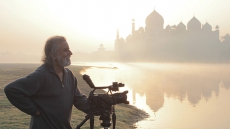“The Guru is my source of light. Attempting to draw how he looked would be akin to bringing the light to the closure of my own thought. The Guru is much larger than, much more divine than my own limitations.”
Let me describe Parminder Singh’s painting “Anandpur: The city of bliss” for you: There is a sprawling field, where the sun-burnt earth from the hot Punjab summers is drunk with the monsoon showers and has turned emerald green. In the distance, you see a hint of a white dome and a Nishan Sahib (Sikh flag). For a moment, I was immersed in the painting, and could almost hear a faint echo of the songs of Guru Nanak reaching my ears.
I met Parminder Singh a couple of years ago in Vancouver, Canada. I came across his painting on Instagram of Baba Maan Singh Nihang along with several of his other works entrenched in the life of the Nihangs (Sikh Samurais)!

Nihangs are the traditional military order of Sikhs, who commit to the lifestyle of the Sikh warriors. The mention of Nihangs - often referred to as Akaalees (Immortals) - was found often in European news wires sent from British India reporting of the Khalsa empire of Punjab. Their ferocity and prowess on the battlefield was instrumental in establishing the largest secular Sikh empire in Punjab under Ranjit Singh.
In the first Anglo-Sikh war, when the Dogra general Tej Singh backstabbed the Sikh army on the Satluj river, burnt the bridges and abandoned the Khalsa Army, about 10,000 Nihangs took the stance to fight than to accept defeat. The British almost banned the Nihang way of life after the fall of Sikh empire in 1845. After Indian independence, and further attempts by the government to tarnish the image of Nihangs, small groups of the Nihung order have survived 150 years of neglect.
Having lived close to Nihangs while growing up in Punjab, Parminder Singh’s paintings explore a fresh perspective on the life of Nihangs. When I met him in his small studio in Surrey, he seemed fascinated by their way of life. Nihangs seem to appear often as subjects in his paintings - but not just their prowess in the battle, but as family men, as caretakers of society - the saints and the warriors.
Parminder Singh is soft-spoken, driven by the ethos of the Sikh and Punjabi traditions, yet keenly aware of the current global affairs. I found his bookshelves lined with books of the renaissance masters - of Michaelangelo, Da Vinci and Van Gogh, along with those of Prof. Puran Singh. His eyes light up equally when he talks about Punjab and the Ten Sikh Masters, and when he talks of Van Gogh’s letter to Theo. Then it dawned on me, choosing to paint Punjabi and Sikh subjects are not his limitations, but his choice.

Yet there was no sign of paintings depicting the face of any of the ten Sikh Gurus. “Is it intentional?” I asked him. “The Guru is my source of light. Attempting to draw how he looked would be akin to bringing the light to the closure of my own thought. The Guru is much larger than, much more divine than my own limitations,” he calmly said.
I met him a second time around the 150th anniversary of Canada. He was painting the Vancouver skyline with a young Aboriginal boy, half in traditional attire and half in colonial clothing. A few days later he posted the painting on Instagram and the tagline read, “It requires sincerity to close that which is open, to stitch that which is raw, to embrace those pushed away, to respect as we expect to be respected, to adopt “sarbat da bhala”, a goodwill for all. The totem poles do not have to sink to make room for skyscrapers. The eagles do not have to stop soaring the skies, just to make room for the flags.”I feel Punjabi culture is going through a renaissance of thoughts, arts and literature.

A new generation of Punjabi poets and painters, native and in diaspora, are breaking the mold of confined perimeters of thought that confined their expression in the later half of last century and finding new meaning in exploring both our past and our future. “I dream of painting and then I paint my dream.” Van Gogh, the famous Dutch Post-Impressionist painter once wrote. Parminder Singh’s painting of the faces and places of Punjab are one of the best impressions of nostalgia, seen from a Punjabi eye, dreamed in a Sikh heart and then beautifully painted on a canvas.

